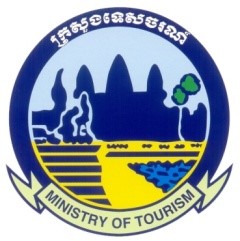BAMBOO INDUSTRY
AHA supports partners of the GIZ- Regional Economic Development Program (RED) in promoting bamboo industry development in one of the most remote districts of Siem Reap province. AHA is not responsible for the information presented on this page
INVESTING IN BAMBOO PLYBOARD IN CAMBODIA
Bamboo plyboardsare produced from bamboo knitted mats and bamboo woven mats that are soaked in adhesive resin and then pressed firmly together in a hot press. They were the first of the wide range of different panel boards presently available that use bamboo as a raw material. Bamboo plyboard is at least as durable and stable as wood-based plywood and is very resistant to pest attack, water and extreme climate condition. It can be used for many of the uses to which traditional plywood is now put such as formwork, paneling, ceiling, wall covering and furniture.
The range of uses to which bamboo plyboards may be used means the market has considerable potential now and for future expansion. Entry level technology making the simplest boards is straight forward and the entry level processing plant requires investment around USD100,000. The establishment of a bamboo plyboard processing operation suits countries like Cambodia where bamboo resources and a low skilled labour force are available
Product and Market
The global market for plywood is forecast to reach 75.9 million m3 by 2015. China is the largest market for plywood worldwide, followed by the US which is poised to reach 16.1 million m3 by 2012. The internationally traded volume of bamboo plywood is USD 132M1 , but a 2006 estimate of the global market for bamboo plyboards was USD200M2.
Bamboo plyboard has similar properties to plywood. Bamboo plyboard can be used for paneling, ceilings, prefabricated shelters, packing cases, storage bins, roofs, doors and door panels, furniture and concrete formwork in construction.
The wide range of uses to which it is put means the market has considerable potential for expansion and bamboo plyboard also has significant export potential. China is the largest manufacturer and market for bamboo plyboard, with production growing rapidly in Vietnam and India. Cambodia’s market for bamboo plyboard looks promising as Cambodia’s housing style requires light materials for flooring, wall coverings and ceilings.Bamboo plyboard is very versatile and can be produced in different thicknesses by varying the number of layers used.
Processing Technology
A simple production line can be purchased in China or Vietnam for around $100,0003 that can produce 1,200 tons of plyboard per year.
Technology has been developed in China and Vietnam and is now mature. Glue is one important issue affecting the quality of board, and a technology transfer package from China or Vietnam for around USD10,000-15,000 should be included in any new project.
Raw Material
Assessment of bamboo resources in Varin district, Siem Reap demonstrate that both suitable species and quantities are available. Planned support to plantation development will secure long term supply. RusseiPrey is the predominant suitable material for both bamboo knitted mats and woven mats. New plantation areas of for example the existing species of RusseiSrok and Russei Ping Pong could also be considered in your project plan.The investment outlined producing 1,200 tons/year of finished bamboo plyboards would require 3,500 – 4,000 tons of fresh bamboo culms per year.
Financials
The proposed 1,200 tons/year output factory can generate a turnover of around $600,000 – $700,000 per year with target selling ex-works price of $500 – $600 per ton of finished boards. While input costs are estimated for $450 – $500 per ton of finished boards. Of which, major input costs include bamboo raw material (around 30%), labor cost (approximate 30%), glue (20%) and other costs like electricity, water, management and sales (about 20%). The fluctuation of input costsdepends on economic scales of output volume and labor productivity. Annual earning from such investment is expected from $50,000 to $60,000.
Payback period of the investment is estimated for 2,5 – 3,0 years with a ROE is expected for 32% – 35% per year on average of 10 years of the investment project.
1 Comtrade 2008.
2 Oxfam Hong Kong- International Finance Corporation, 2006.
3 This is cost of machinery and equipment, it does not include infrastructure like land and building.
Do you want to know more about exciting business opportunities in bamboo processing? Please contact
Mr Torsten Münther (English) Mr Khim HENG (Khmer and English)
Economic Development Advisor Value Chain Coordinator
Tel.: 012 272 139 Tel.: 089 59 56 68
torsten.muenther@giz.de khim.heng@giz.de
GIZ-Regional Economic Development Program (RED) Green Belt – Siem Reap Province

Administrative City Siem Reap
P.O. Box 93221
17000 Siem Reap Angkor, Cambodia
Tel: (855)-063 76 03 04, Fax: (855)-063 76 19 31

Publications
Cultivation
- INBAR-Tropical-Bamboos-Propagation-Manual.pdf
- INBAR-A-Manual-for-Vegetative-Propagation-of-Bamboos.pdf
- INBAR-Community-Bamboo-Nursery.pdf
Processing
Investment Opportunities
- Investing-in-Bamboo-Lamination.pdf
- Investing-in-Bamboo-Shoots.pdf
- Investing-in-Bamboo-Sticks.pdf
- INBAR-Bamboo-A-Sustainable-Solution-for-Western-Europe-Design-Cases-LCAs-and-Land-Use.pdf
- Bamboo-Sticks-Prospectus.pdf
Climate Change
- INBAR-Bamboo-and-Climate-Change-Mitigation.pdf
- INBAR-Capturing-Carbon-With-Bamboo.pdf
- INBAR-Bamboo-A-Strategic-Resource-for-Countries-to-Reduce-the-Effects-of-Climate-Change.pdf




